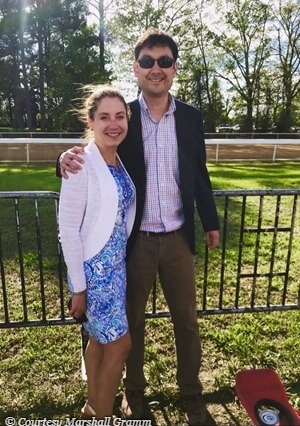April 2019 Member of the Month: Marshall Gramm

Teresa and Marshall Gramm
Marshall Gramm is the TOBA April Member of the Month.
Rarely do Thoroughbred racing and academia collide. But Dr. Marshall Gramm, economics professor at Rhodes College in Memphis, Tenn., is changing all that. Also co-owner of Ten Strike Racing partnership, Gramm teaches students statistics by immersing them in the world of handicapping.
The son of two economists—father Phil Gramm is also a former Texan senator—Gramm was fascinated by sports from an early age. He recalled, “And so when I was a boy growing up in Washington, D.C., we also didn’t have cable television. So I was a sports nut, but we didn’t have cable.” He plunged into newspapers’ sports pages—but his analysis came in the form of going deep into horses’ past performances, rather than RBIs and games played. Gramm recalled, “I became very interested in horse racing. As a kid, I would get two dollars and make the mile walk to the drugstore to buy the [Daily] Racing Form.”
Years later, while working on his doctoral thesis at Texas A&M, Gramm was conducting research on banking regulation. He found that different models of economic analysis piqued his interest. “I realized that there’s a fairly substantial research on using…horse racing data […] to look at the studies of how efficient markets are” in global economics, Gramm said. Handicappers decide potential outcomes of races based on incomplete information, a model very applicable to financial situations.
Gramm utilizes Thoroughbred racing data in upper-level statistics courses, including his Economics of Racetrack Wagering Markets class. Gramm said, “It’s really about handicapping horse races and we do a lot of economics-related stuff. We talk about pricing, we talk about information, we talk about decision-making with small sample sizes.” He added, “The kids have learned to read the Form; they’ve learned to understand the tote board” and pricing information. Gramm is also an accomplished handicapper. “I’m an avid horseplayer,” he said. “I play the horses, sort of all the time. I had a pretty good tournament run: I finished ninth in the [2019] National Horseplayers Championships[…] in Las Vegas.”
Placing fifth in last fall’s Breeders’ Cup Betting Challenge, Gramm regards himself as a “horseplayer first,” a horseman second. Gramm commented, “All the horses I own are in Ten Strike Racing, which is a racing syndicate that Clay Sanders and I are founding partners [in], and Liz Crow is our agent and stable manager.” Partial or outright owner of 60 horses, Gramm has 40 horses currently at the racetrack. Ten Strike was named leading owner at Parx Racing in 2017 and 2018.
Their most successful runner thus far is Long On Value, which Ten Strike co-owns with Sol Kumin’s Madaket Stables and Steve Laymon. The son of Value Plus took the 2018 Highlander Stakes (G1T) at Woodbine and entered stud this year at Pleasant Acres Stallions, in Morriston, Fla. Gramm just bred a mare to Long On Value, saying, “That’s a vanity play. Numerically, that makes no sense, but some of the partners were interested in breeding to Long On Value and I got a mare, and we bred to Long On Value and it should be a lot of fun.”
In 2008, Gramm claimed the Gulch mare Aunt Dot Dot, from whom he bred Dot Matrix (by Freud). Dot Matrix captured the July 14 Warrior Veterans Stakes at Indiana Grand Race Course. “He’s been a lot of fun to own,” said Gramm. Aunt Dot Dot also produced the multiple stakes-winning filly Aunt Ellipsis (by Successful Appeal). Another excellent purchase for Graimm came when he claimed Divine Elegance for $50,000; Gramm sold her, in foal to Tapit, for $750,000 at the 2018 Fasig-Tipton Kentucky Fall Mixed sale.
Probability keeps Gramm’s expectations realistic. “I tend to never think about, ‘This horse is going to improve and be a nice horse,’” he said, adding, “I’m often thinking about, ‘Hey, here’s my downside risk; let’s try to minimize that.’ I tend not to be a dreamer.” As a result, breeding presents an interesting challenge. Gramm said, “There’s a lot of data out there on breeding, but my decision making—you never get to see your outcomes, because you have so few repeated experiments.” He added, “My breedings, I just do three or four of them a year. I’m a breed-to-race guy, so […] I want stallions that throw sound runners, that are maybe undervalued by breed-to-sell people.”
Gramm boards his mares at Pin Oak Lane Farm near New Freedom, Penn., and Keane Stud near Amenia, N.Y. He went on to say, “My mares are all race mares; they’re all mares that had some success on the track. And that’s kind of always what I look for: pedigree, along with some race success, and then I breed them to stallions who at least statistically throw runners and already established and sort of fit within the budget for someone who’s a breed-to-race guy.”



